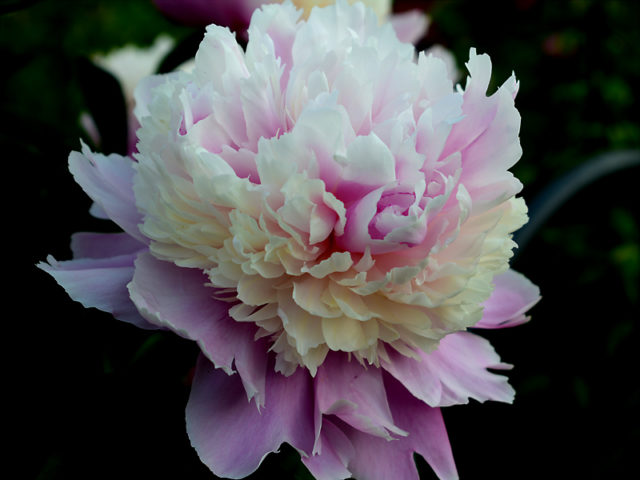Content
The peony Sorbet, loved by flower growers, was named after the famous fruit dessert. Its extraordinary popularity is due to its unique flowering and ease of care. Compliance with the basic rules of cultivation enhances the decorative effect of the peony and protects it from diseases.
Description of lactic-flowered peony Sorbet with photo
Sort "Sorbet" belongs to the milky-flowered species of perennial herbaceous peonies. Strong shoots grow rapidly and during the growing season the bush reaches a height of 80-100 cm. The leaves are large, dissected and pointed, dark green in color. They do not lose their original decorative effect until the end of the growing season, changing color at the end of the season to crimson. The bush is compact - it grows in breadth up to 80-90 cm. To prevent the branches from falling apart, use a support in the form of a ring.

Peony flowers can become a decoration of the landscape of a summer cottage or personal plot
Sort "Sorbet" is hardy to zone 3, which indicates high frost resistance. The root system is able to survive temperatures as low as 40 ° C even without high snow cover. Peony "Sorbet" can be cultivated almost throughout Russia. It is drought tolerant and tolerates light shade. Sunny areas are ideal for growing this variety. The greatest decorative effect of the plant is manifested when grown in nutritious and well-drained soil.
Flowering features
Sorbet peony flowers are double and have an interesting three-layer structure. Outside there is one row of large pink petals, in the middle there is a large number of narrow beige ones, inside the wide pink petals are gathered in a crown. This variety impresses not only with its unique flowers, but also with a pleasant persistent aroma.
Flowering begins in the first half of June and lasts 2 weeks. During this period, the petals gradually lose their original brightness, becoming pale pink on the eve of wilting. The maximum diameter of flowers is 20 cm. Their size and number depend, first of all, on the illumination. In deep shade, a peony may not throw out a single bud.

Flowers have a unique three-layer structure and a persistent aroma
Application in design
The endurance of the Sorbet peony has made it an indispensable crop for the beautification of public gardens and parks. Compact bushes look spectacular near a house or a pond, as well as as a hedge zoning a space. Sorbet is ideal for planting along walls, in parks and alleys. The neat dark green bushes go well with most ornamental plants.
Successful options for using the Sorbet variety in group plantings:
- with small coniferous or deciduous crops;
- in the vicinity of small-flowered plants;
- in the center of a round flower garden;
- in the background of a long flower bed;
- as an element of a multi-tiered flower bed.
The advantage of Sorbet peonies is that after flowering, their beautiful crown becomes a suitable background for the flowering of other plants. For the neighborhood, it is better to select crops with lush greenery. Thuja, barberry, daylily, honeysuckle, sage, cloves, irises, phloxes, and asters work well.
Reproduction methods
Sorbet milky peony is propagated in three ways:
- layering;
- cuttings;
- dividing the bush.
The first two methods are too laborious and time consuming. Usually they are applied to new varieties with inaccessible or expensive planting material. Propagation by layering and cuttings gives a large number of seedlings with preserved varietal characteristics.
Dividing the bush is a simple and safe way to propagate herbaceous peonies. It is in this way that planting material is produced for sale. The best period for dividing the roots of Sorbet peony is considered to be the beginning of autumn, when the buds are dormant.
Landing rules
When choosing a place for planting Sorbet peony, priority is given to lighting. Ideal when direct sunlight falls on the bush all day. Partial shade is allowed for several hours. If the peony is in the sun for less than 6 hours, it will not bloom.
It is recommended to plan the planting of Sorbet peony at the beginning of autumn. Favorable natural conditions and dormant buds will help it quickly take root. Planting is done immediately after dividing or buying a root. There are no rot and stains on high-quality planting material, but there are 3-5 living buds. It is prepared by soaking in a biostimulant solution.
Planting of Sorbet peony is carried out according to the following scheme:
- Dig a hole 50 cm deep and wide.
- Lay a drainage layer.
- Fill up the earth mixed with compost and humus.
- A week later, the root is planted, deepening the upper bud by 5 cm.
- Water the plant abundantly.
- Mulch the landing site.
The distance between neighboring Sorbet peonies should be at least 1 m. The knocked down soil can be loosened with peat and sand. Dried leaves, grass, sawdust or peat are used as mulch.
Follow-up care
The value of the Sorbet variety is in its ease of care. The plant is rarely watered, but abundantly. At a time, use 2-3 buckets of previously settled water. Leaves should remain dry after watering. Periodically, the ground under the terry peony is loosened and mulched. Withered flowers are immediately cut off so that they do not provoke diseases.
In the first year after planting, the plant has enough nutrients. Then, at least three additional dressings are made per year:
- Organics - in the spring.
- Mineral mixture - during the budding period.
- Complex feeding - immediately after flowering.
Herbaceous peonies can live in one place for up to 7-10 years. But experienced growers are advised to divide and replant the bushes every three years. This promotes plant rejuvenation and protection from disease. Damaged planting material is discarded. Preventive spraying of peonies against pests and fungal diseases should be carried out annually.
Preparing for winter
The beginning of September is the time for the introduction of potassium-phosphorus fertilizing, if the peony is grown in infertile soil. This will prepare the plant for wintering. In mid-October, before the onset of frost, Sorbet peonies are pruned. Leave 2-3 cm from the length of each shoot. An adult plant does not need shelter for the winter. In regions with harsh climates, gardeners recommend mulching the planting site.

For the winter, the ground part of the Sorbet peony is cut
A young plant needs winter shelter. It is made from spruce branches, sawdust, peat, unripe compost or covering material. In the spring, as soon as the soil thaws, the shelter is removed so that the buds "wake up" faster.
Pests and diseases
Most often, peonies suffer from viruses carried by sucking insects. When the first symptoms are detected, measures should be taken immediately, since the infection occurs instantly. Peonies infected with viruses become easy prey for various fungi. The flower can become infected from cucumbers, tomatoes, beans, potatoes and other garden crops.
The main disease of Sorbet peonies is the tobacco rattle virus. It manifests itself in a bright marble pattern or stripes on the leaves.There is no cure for viruses, so all that remains is to provide careful care and isolate diseased plants from healthy ones. It is important to regularly spray against diseases caused by fungi and pests.
Fungal diseases of peonies | Signs |
Gray rot | The stems are covered with gray spots, they rot |
Rust | Leaves cover yellow or brown spots |
Cladosporium | Brown or dark brown spots appear on leaves, stems and buds |
Septoria | Leaves on both sides are covered with yellow-brown spots |
Root rot | Roots and stems rot |
The herbaceous peony Sorbet has few pests: bronze beetles, ants, rootworm nematodes, aphids. They are especially annoying for plants planted in shady areas. Ants are dangerous by the spread of aphids, which carry the virus. Modern fungicides and insecticides help to successfully fight fungal diseases and pests of peonies.

Ants spread aphids, which can be controlled by insecticides
Conclusion
Every year Sorbet peony gains more and more admirers. Its graceful three-layered flowers amaze the imagination and delight with a delicate aroma. The lush greenery remains decorative until the end of the season, creating the perfect backdrop for other flowering plants. Compact shrubs are easy to combine with most ornamental plants. For full development, Sorbet peony needs good lighting and infrequent abundant watering. It is extremely negatively affected by deep shadow and stagnation of moisture in the soil. Regular feeding is necessary for a peony for lush flowering and protection from disease. Even a harsh winter, he tolerates well without shelter.
Reviews about peony Sorbet
The Sorbet variety has received a large number of positive reviews from growers from different regions. First of all, they note the unpretentiousness and gorgeous flowering.
Lovers of peonies have appreciated the unique Sorbet variety. It is easy for him to find a place on the personal plot, because it goes well with many cultures. The full potential of the plant is revealed with an abundance of sunlight and adherence to simple care rules.








